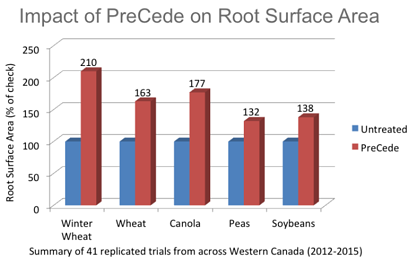This year, many growers are experiencing cold soils and adequate moisture levels — conditions in which a seed nutrient dressing really pays off. Read on to learn more about what to expect from treating seed with nutrition.
What should we expect from treating seed with nutrition?
The aim of seed nutrition is to cold start the crop, ensuring early season vigor and increasing the root surface area. The use of a seed nutrient dressing, such as PreCede, with a seed fungicide product can increase root surface area by 30-100% compared to the untreated seed. This significant increase in root surface area better enables the plant to secure the water and nutrients it will require to reach its genetic potential.


Image 1: Check (left side) vs. PreCede Soybean-treated (right side).
Image 2: PreCede has been specifically formulated for each crop to increase the root surface area.
Seed nutrient dressings, such as PreCede, are not designed as replacements for seed fungicide dressings but rather to complement them under the Chemtrition platform. When combined they have a great synergistic effect.
For a list of all the seed treatments PreCede is compatible with CLICK HERE.
Seed nutrient dressings can be expected to provide a yield increase of around 1-3 bu/ac. The main benefit of a nutrient dressing is to balance the nutrients in the seed during the 1-2 leaf growth stage to ensure that the plant can maximize its early photosynthetic efficiency and achieve its genetic potential.
Two additional points to be aware of when it comes to seed nutrient dressings:
- For all pulse crops that are being treated with rhizobium: do not apply seed nutrient dressings containing phosphorus, zinc, copper, manganese or iron since it will kill the rhizobium. Use a rhizobium-friendly product that has been approved for use on pulse crops, such as PreCede Pulse and PreCede Soybean.
- Seed nutrition can only correct nutrient imbalances within the seed. It does not correct any deficiencies that may occur in the soil. A proactive soil-applied nutrient plan, based off a soil test, is the best way to address potential soil limitations.
Seeds are nutrient imbalanced. Enriching the crop with the proper nutrients and biological activators help the crop have an optimum start, reduce early season risk and allow the seed to achieve more of its full genetic potential.